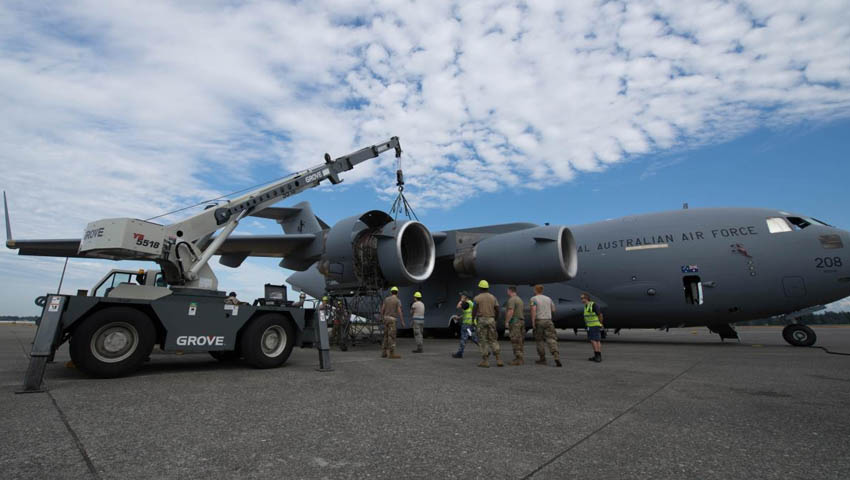A recently signed arrangement with the US has expedited the Royal Australian Air Force’s No. 36 Squadron getting one of its C-17A Globemasters back on mission.
To continue reading the rest of this article, please log in.
Create free account to get unlimited news articles and more!
The aircraft, which had suffered a cracked engine inlet during a mission to Alaska in late August, was repaired under the Aircraft Repair and Maintenance Service – Implementing Arrangement (ARMS-IA).
It allows C-17A technicians from the RAAF and US Air Force to work on each others’ aircraft. Even though RAAF and USAF C-17As are exactly the same, the maintenance workforces from both countries differ significantly in how they are qualified in their role.
Warrant Officer Pete Ranson, the Warrant Officer of Engineering for No. 36 Squadron, said the crack on the engine inlet was located on the anti-ice duct – the bare metal ring on the ‘lip’ of the engine housing.
"The jet arrived at Elmendorf Air Force Base in Alaska on August 30, and the crack was detected as part of the post-flight inspection," WO Ranson said.
The inlet repair marked the first time that USAF technicians have supported a RAAF C-17A ARMS-IA. Last July, technicians from No. 36 Squadron supported two USAF C-17As requiring maintenance in Australia.
The anti-ice area of the inlet ensures ice doesn’t form on the front of the engine housing while flying in moist air. Left unrepaired, a cracked inlet could have potentially catastrophic results for the engine housing and aircraft if it came apart in air.
For No. 36 Squadron, the first order of business was to decide where the repair would need to be conducted.
Australia is a signatory to the Globemaster III Integrated Sustainment Program, which sources spare parts from the nearest warehouse – including in the US.
While Elmendorf Air Force Base is home to a USAF C-17A squadron, the nearest replacement inlet was at McChord Air Force Base near Seattle in Washington.
Warrant Officer Ranson added, "Boeing released an engineering disposition to stop-drill the crack, and authorised a one-time ferry flight from Elmendorf to McChord. The amount of cracking was deemed acceptable enough to allow a short ferry flight."
Once at McChord, maintenance personnel from the USAF’s 62nd Maintenance Squadron worked to change the engine inlet under RAAF supervision.
The engine inlet measures 1.99 metres in diameter and weighs 248.5 kilograms. While not regarded as a difficult item to remove and fit to the engine cowling, the inlet still requires a crane and a steady hand due to its size and weight.
The work was completed over three days in September and the No. 36 Squadron team was back flying on their mission.
"Without ARMS-IA, maintenance personnel would have had to be deployed from Australia to the aircraft’s location. No. 36 Squadron is often experiencing a high operational tempo, and the longer an aircraft is unavailable, the greater the impact on other missions we’re tasked in support of," WO Ranson said.
Australia's fleet of C-17A Globemaster III provide the Air Force with an unprecedented capacity for strategic airlift. It allows Australia to rapidly deploy troops, supplies, combat vehicles, heavy equipment and helicopters anywhere in the world.
Based at RAAF Base Amberley, all eight C-17As are operated by No. 36 Squadron and provide a logistics backbone for Australian Defence Force operations overseas. This has included operations in the Middle East and Afghanistan, as well as East Timor.
Stephen Kuper
Steve has an extensive career across government, defence industry and advocacy, having previously worked for cabinet ministers at both Federal and State levels.

 Login
Login








